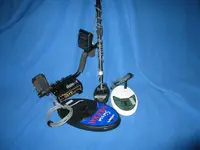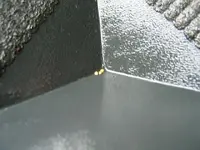This following is in reference to VLF (induction balance) detectors. PI (pulse induction) is a different thing entirely where frequency is rarely discussed except as relates to electrical interference.
Frequency does two things. First, the target itself. Higher frequencies hit harder on small targets. Not gold per se, small targets. Take a common BIC type ball point pen, the type where the entire pen is plastic except for that little ball in the point. No other metal. A good gold detector will pick that ball up. A coin detector, you can write your name on the bottom of the coil and get no signal.
Low frequencies do not detect deeper. That is a broad statement with no meaning. In air tests high frequencies will detect farther, and on small targets a low frequency detector will miss it is obvious the higher frequency detector goes deeper.
The second thing frequency does is change ground response. Low frequencies do not react to ground and hot rocks as much as high frequencies. So that hot Gold Bug 2 also picks up ground and hot rocks better, and this means it gets very poor depth on larger targets in highly mineralized ground. It gets great depth on large targets in the air or in no mineral ground, but add mineral and the depth drops rapidly.
Detectors that work under 10 kHz hit very well on coin size targets and have a low ground response, making them great coin machines, but they have poor small item sensitivity. Detectors over 20 kHz are hot on tiny targets but have more issues with ground and hot rocks. Detectors in the teens are chosen as a best all around solution for do it all detectors. People used to coin detectors find them "noisy" as they tend to chatter on small targets and ground that a coin detector, designed for smoother operation and depth on coin size targets, will ignore.
People always ignore one thing when they go on about the Minelab multi-frequency detectors. They focus on the so-called high frequencies employed. It does not matter. What does matter is those detectors are designed to find silver coins and are tuned and act like lower frequency detectors. Do not let specs blind you to reality. If multi-frequency were good for nugget hunting Minelab would make multi-frequency nugget detectors. They do not, nor does anyone else. The nugget machines run at one frequency to put all the power into one frequency instead of sharing it among multiple frequencies. I am not saying the Minelab units will not find gold - my CTX 3030 is a jewelry killer. But it is not a hot nugget machine.
There is another thing frequency does, and that is deal with electromagnetic interference (EMI). Some frequencies like the 30 and 40 kHz range get avoided due to interference issues.
Finally, the nugget market is saturated and most serious, that is to say "been at it awhile", nugget hunters already have their detectors. The AT Gold does just fine compared to other mid-frequency detectors. The thing is it also does no better than anything else out there for years. So nobody is rushing to replace the detector they have with the AT unless they need a waterproof nugget detector, a rare requirement indeed. Most guys hunt in deserts. People mention what they have and what has been around for years and the AT is a new kid on the block. Bottom line is as a nugget hunter, take away the waterproof, and it is just another good detector along with a half dozen others.
To sum up, the higher the frequency, the better the response on small targets, and the better the air test. But the higher the frequency, the more response to ground and hot rocks. The two work against each other, and a detector has to balance the two parts of the equation. Mid frequencies are basically just the best compromise. Multi-frequency units just think of as lower frequency units and you will be fine.
Steve Herschbach
DetectorProspector.com
 Thanks
Thanks


 ...........Todd
...........Todd


 , except I will hang onto it.
, except I will hang onto it. , then I'll repeat the test with the setup you suggested, except I'll be using a test frame I made pictured below......it's all wood, plastic and rubber (no metal.).
, then I'll repeat the test with the setup you suggested, except I'll be using a test frame I made pictured below......it's all wood, plastic and rubber (no metal.).
 !
! Of course, the depth range will increase as the size of the gold increases and more eddy-currents are generated.
Of course, the depth range will increase as the size of the gold increases and more eddy-currents are generated. 


